Hello everyone and welcome to another week of Shatter Perceptions, the weekly Commander-minded article series where I build skeletons for off-the-beaten-path Commander decks. Normally I would spotlight the general of the week and breakdown the desired deck I would build towards. But this week we’re continuing the off format arc started last week and looking at the Dragon, Wizard and Vampire generals coming out of Commander 2017 and discussing what a deck might look like with each general. Admittedly, I’m pretty excited by what we ended up getting overall, especially the return of Phasing and [casthaven]Magus of the Mind[/casthaven] bringing Storm back in a modified way. But I don’t want to delay any further, we have a lot to cover.
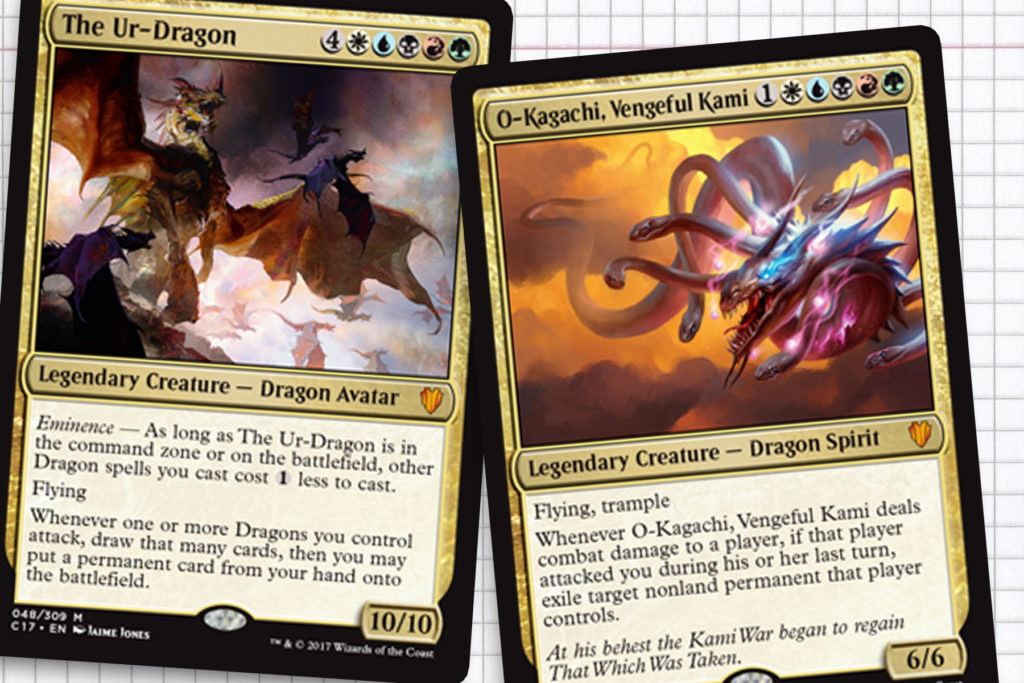
Not Just Blowing Smoke
I spend a lot of time on the internet and while I won’t talk publicly about the spoilers that end up on Reddit or what-have-you, I saw the Commander 2017 leak—I think during my time away with the newborn—and was very excited by [casthaven]The Ur-Dragon[/casthaven] and the deck it represented.
I am not an avid Dragon player in Commander; so where a seasoned Dragons player might have an entire scope of ideas for [casthaven]The Ur-Dragon[/casthaven], I see it as a very strong lord for a Tribal deck. I think the first ability making Dragons cost less overall is great, but the second ability is really where I would want to invest the most brain power into drawing giant swaths of cards and dumping powerful permanents like [casthaven]Crucible of Fire[/casthaven] or [casthaven]Coat of Arms[/casthaven] into play. I suppose that might be what makes the deck less interesting for me; once your general lands, you could very well wipe an entire table in one swing. I like games moving forward and I think spontaneous Archenemy games can be a blast, so maybe this will be that deck at any table it reaches.
[casthaven]O-Kagachi, Vengeful Kami[/casthaven] has gotten a slight facelift since we last saw them on [casthaven]Final Judgment[/casthaven]—though it might just be a difference of perspective—but either way, the Kamigawa fans finally have the five color legend we missed out on 14 years ago. I like that Wizards played into the flavor of Kamigawa and the nature of some of the more whimsical monsters there and made this a Spirit Dragon. And I think that might be the direction I would take this deck, Kamigawa Fatty Spirits. While it might not be powerful, but the ability to summon [casthaven]Keiga, the Tide Star[/casthaven], [casthaven]Myojin of Night’s Reach[/casthaven], and [casthaven]Kodama of the Center Tree[/casthaven] all in one deck seems pretty fun! So grab your [casthaven]Urza’s Incubator[/casthaven], [casthaven]Long-Forgotten Gohei[/casthaven], and as many Myojin/Spirit Dragons as you like and just build something flavorful to the plane.
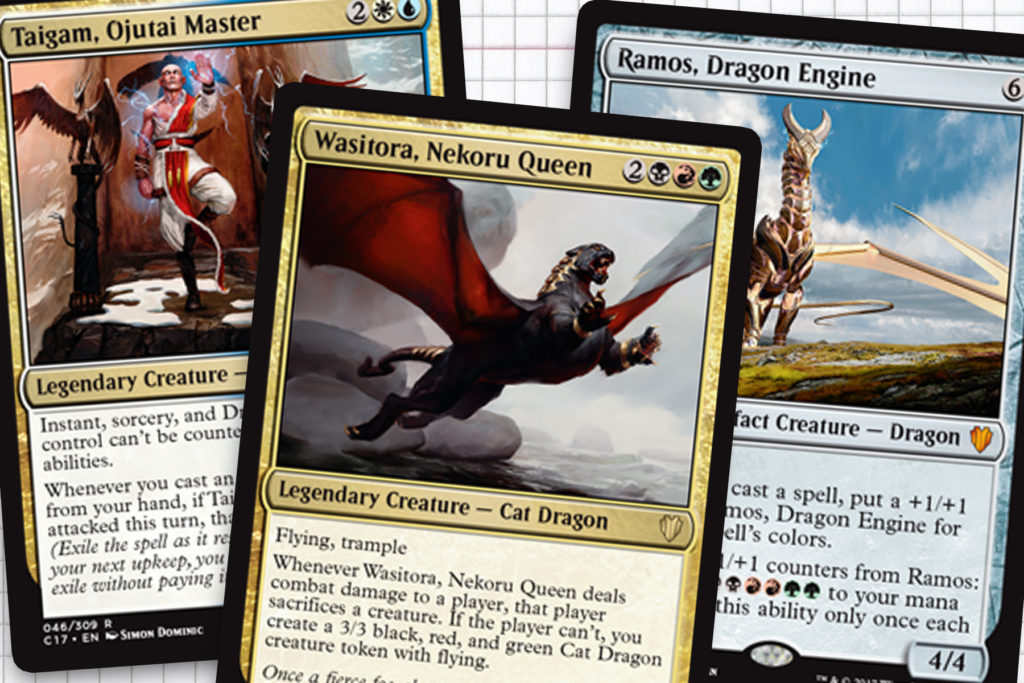
Next up with have [casthaven]Ramos, Dragon Engine[/casthaven], aka the [casthaven]Door to Nothingness[/casthaven] Engine. This is flavor gem—we have plenty more to come—that even I had heard of without digging too far into the lore of Tempest beyond “Where did all these Slivers come from?” With a mixture of strategies straight out of Abzan and the Simic, I believe Ramos could work in a pretty stellar space, assuming you have something to do with all the mana it can generate once per turn under the right circumstances. This deck will require a pretty tight use of the Seven by Nine theory as to not become too schizophrenic in its gameplay—keeping in mind things like Converge ([casthaven]Bring to Light[/casthaven] or [casthaven]Infuse with the Elements[/casthaven] come to mind), [casthaven]Experiment Kraj[/casthaven], or the aforementioned [casthaven]Door to Nothingness[/casthaven], while also valuing the importance of card draw and removal.
[casthaven]Taigam, Ojutai Master[/casthaven] sits in a weird place for me. He protects your spells from becoming countered and he gives you spells Rebound, provided you’ve satisfied a Raid trigger. [casthaven]Narset Transcendent[/casthaven] has taught me that not all spells benefit from Rebound in the same way, so with Ojutai Taigam at the helm I am unsure what you’re looking to cast in terms of instants and sorceries post combat that will retain value when cast again on your upkeep. As a starting block, I might think of Taigam as a [casthaven]Talrand, Sky Summoner[/casthaven] deck that can now include white and hope for the best. You will love rebounding [casthaven]Brainstorm[/casthaven], but [casthaven]Sphinx’s Revelation[/casthaven] is null here.
Rounding out the Dragon deck we have [casthaven]Wasitora, Nekoru Queen[/casthaven], who I happen to like for her open-ended uses. If there was a deck I would want acting like the Jund decks from Zendikar Standard, this would be an early contender. By using cards akin to [casthaven]Blightning[/casthaven] and [casthaven]Bituminous Blast[/casthaven] to get extra card advantage and remove our opponents’ creatures, we can make Wasitora’s combat damage trigger that much better and generate Cat Dragons! The deck as I would build it might not skew as vindictive as the [casthaven]Patron of the Nezumi[/casthaven] deck I outlined last month, but I would strongly consider cards like [casthaven]Magus of the Abyss[/casthaven], [casthaven]Innocent Blood[/casthaven], and [casthaven]Firespout[/casthaven] to reduce the board presence of the other players. Wasitora is all we care about until the tokens start pumping out.
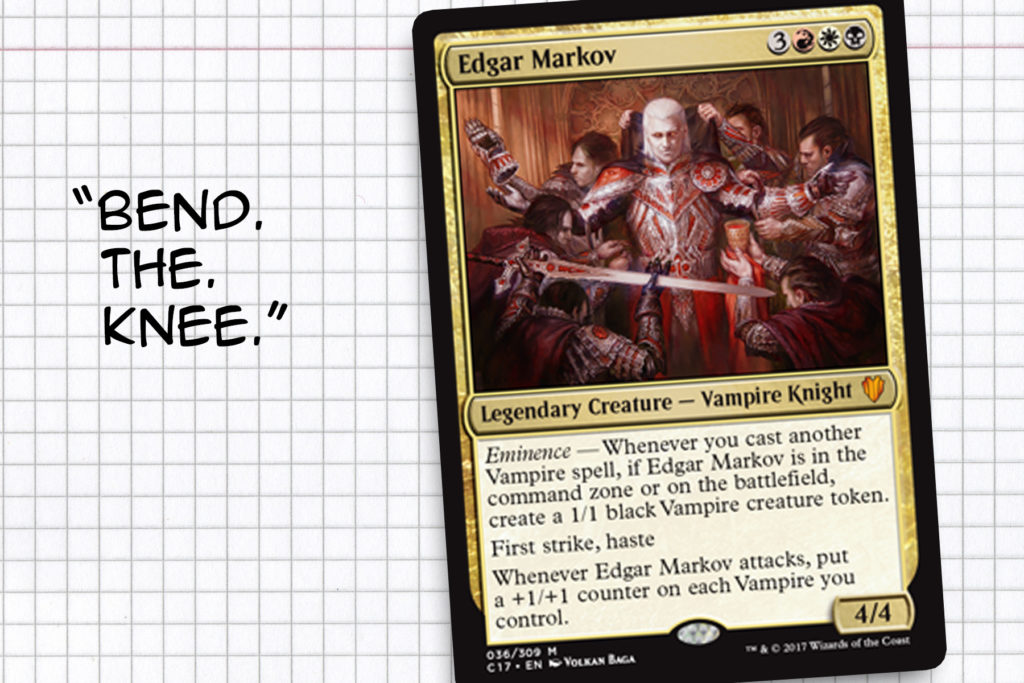
Sinking Your Teeth In
I don’t remember where I first saw the art for [casthaven]Edgar Markov[/casthaven], but I remember the Vorthos community becoming very excited as they pieced together the story before Wizards was allowed to confirm anything. I think the wait—through two visits to Innistrad—was well worth it, as Grandaddy Markov is an excellent general, as the marquee commanders all seem to be. Like when people misevaluated the Allies that gained +1/+1 counters during Zendikar, I think it’s easy to overlook the Eminence on Edgar at first, but this is gaining you value from the very first turn if you build towards it. Like [casthaven]The Ur-Dragon[/casthaven], this card review is a little stunted, because really there’s no question that you’re best bet is building a Tribal deck and benefitting from all the sweet Vampires from Magic’s history.
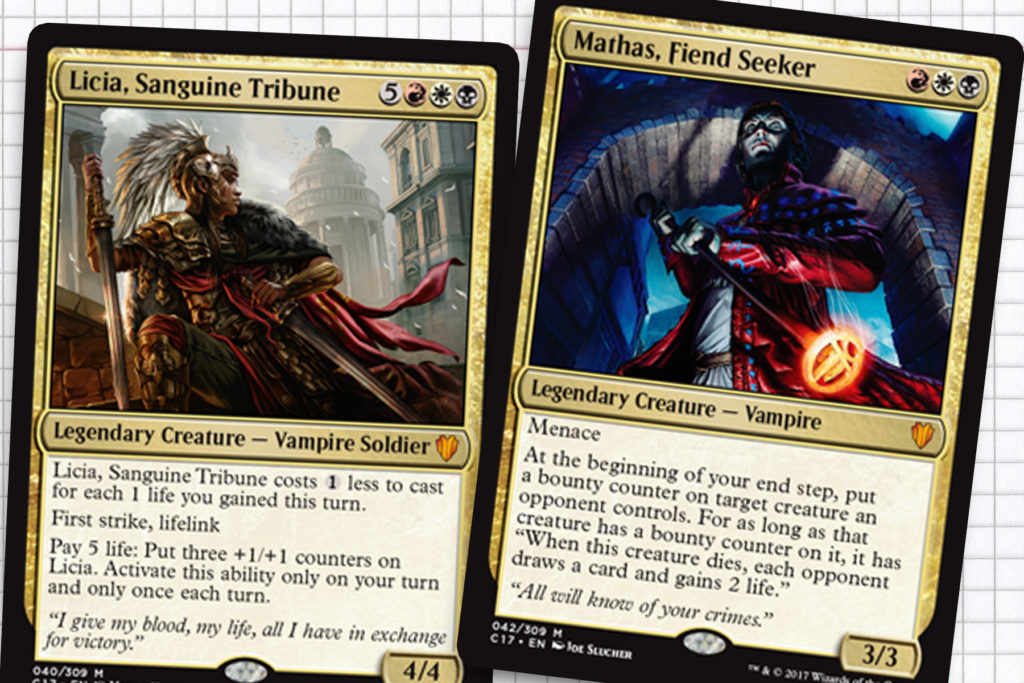
It might be the bookends of excitement around them or just personal bias, but of all the generals I have talked about this week and last, the next two have gotten the least time in my brain to cook. With [casthaven]Licia, Sanguine Tribune[/casthaven] life gain is the name of the game since they are really the anti-[casthaven]Rakdos, Lord of Riots[/casthaven] while ironically being within a Rakdos color identity. I am overjoyed to finally have a use for [casthaven]Rest for the Weary[/casthaven] in Commander, along with cards like [casthaven]Blessed Alliance[/casthaven] and [casthaven]Butcher’s Glee[/casthaven]. Gaining more life than you spent mana isn’t really a challenge, as life gain often as seen as having such little value that they tag it onto spells to fill in that extra half mana in the casting cost. Red feels like the outlier here, as other than allowing us access to [casthaven]Lightning Helix[/casthaven] or [casthaven]Rakdos Ragemutt[/casthaven], I don’t really feel it has a required place in the deck.
Seasoned Commander players have probably seen or at least heard of the [casthaven]Kaervek the Merciless[/casthaven] “Group Slug” deck, but what I never conceived I’d see in a general that includes the Rakdos color identity was a Group Hug deck: enter [casthaven]Marthas, Fiend Seeker[/casthaven]. This has to be a political player’s dream—you get to play in aggressive colors while also benefiting off creatures dying by gaining card advantage. The red flag I see is the three different mana symbol as the only part of the casting cost. As a [casthaven]Doran, the Siege Tower[/casthaven] player, I can attest to how much deck space needs to be dedicated to ensuring you have all your colors on turn three, and Marthas has an ability I would want on turn three. Once your mana base is in place, I would flood the board with cards like [casthaven]Norn’s Annex[/casthaven], [casthaven]No Mercy[/casthaven], and [casthaven]Alhammarret’s Archive[/casthaven] to stay safe and gain more card advantage than the rest of the table.
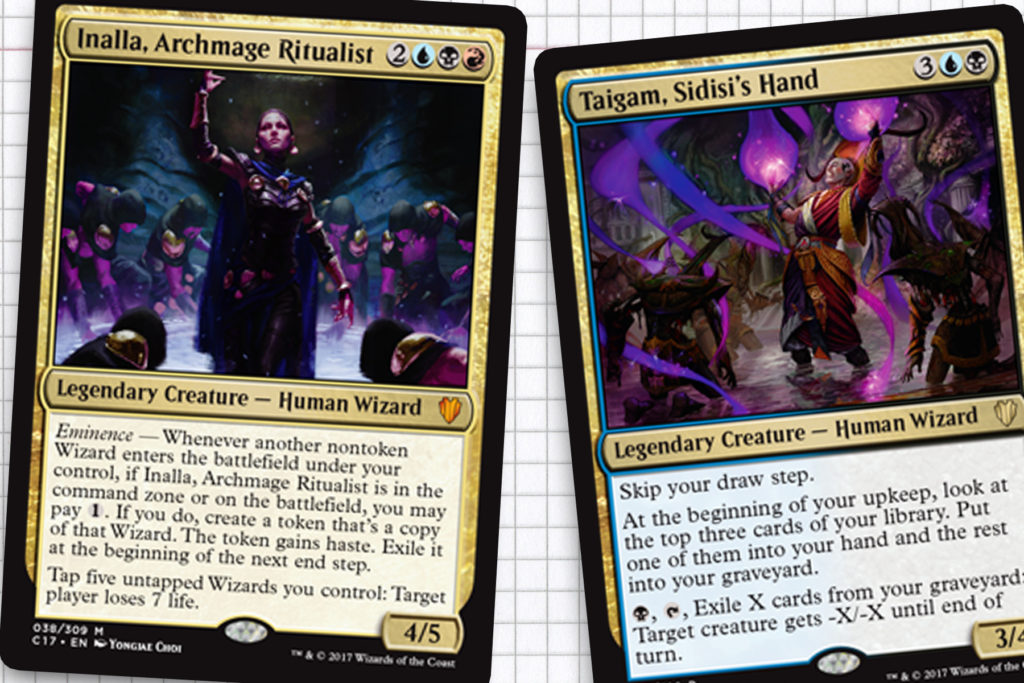
Why Patron Wizard Spiked
At first glance [casthaven]Inalla, Archmage Ritualist[/casthaven]’s Eminence ability looks powerful, but I wondered how many Grixis Wizards you’d really get considerable benefits from cloning in the early stages of the game. Clearly, in the last game the extra bodies can feed into the tribal ability and close out games, but I had to do some digging before I was ready to make any definitive calls on Inalla’s power level. As it turns out there is quite a bit of spiciness going on here, so I will just list off a few interactions even I found: a copy of [casthaven]Beguiler of Wills[/casthaven] can come down and take advantage of your larger-than-average creature count and nab something from another player unannounced; [casthaven]Dragon Mage[/casthaven] and [casthaven]Magus of the Jar[/casthaven] can both flush out people’s hands; two [casthaven]Master of Waves[/casthaven] make a lot of tokens; having a token copy of [casthaven]Mistbind Clique[/casthaven] champion the original can lock down a board quickly; and with additional copies of [casthaven]Riptide Chronologist[/casthaven], you can probably drain someone down from 21 or even 40 life out of nowhere. You’re welcome.
While active members of the online Magic community knew about [casthaven]Taigam, Sidisi’s Hand[/casthaven] the day before he was previewed—via the Magic Story Podcast—I personally feel this was one of the better curveballs we got thrown. The choice to have both Tarkir timelines of Taigam represented in Commander 2017 was a great call by Wizards. That said, [casthaven]Taigam, Sidisi’s Hand[/casthaven]’s use is in his name. I think he works best as a part of the other 99 in a [casthaven]Sidisi, Brood Tyrant[/casthaven] deck. But if I had to find a deck with Taigam at the helm, I think the most obvious part is that we would be very interested in self mill with card likes [casthaven]Damnable Pact[/casthaven] or [casthaven]Forbidden Alchemy[/casthaven] and using the last ability—which I have seen getting dumped on, whereas I see it being as useful as [casthaven]Drana, Kalastria Bloodchief[/casthaven]’s activated ability—to keep threats of the table. I just don’t know what you’re looking to do once you’ve reached Stage Three in your game plan, probably combo off in someway that doesn’t require your graveyard.
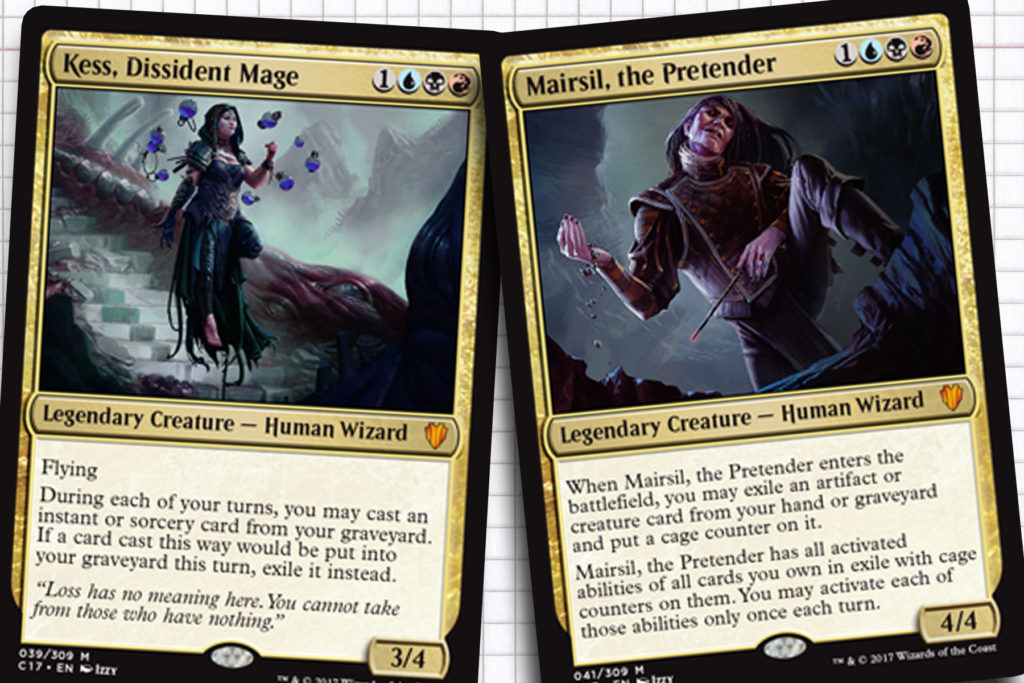
In my eyes [casthaven]Kess, Dissident Mage[/casthaven] has the opposite problem that [casthaven]Taigam, Ojutai Master[/casthaven] has. I want this deck filled with cards I will want to “flackback” once per turn. This is not say that Kess is at all a general to scoff at—I think Kess might be easier to work with overall. I can see a self-mill subtheme being present with spells like [casthaven]Rakdos’ Return[/casthaven] or [casthaven]Mind Grind[/casthaven] being rebought from the graveyard. The restriction to only one instant or sorcery on each your own turns keep this from being completely busted, but doesn’t stop you from running out a Storm finish from your graveyard. And that’s where the deck spirals out of my talents and into a more combo player mindset, I would just want to make all my draw spells function like [casthaven]Think Twice[/casthaven].
Every Commander set has at least one card that catches a wide swath of the community’s attention and [casthaven]Mairsil, the Pretender[/casthaven] seems to be that card. The lore people love this card, the deck builders love this card, and I really adore this card. I think where it starts is in its open-ended nature, where deck slots can drastically change what the deck helmed by Mairsil will be capable of. [casthaven]Aetherling[/casthaven] is an early shot called. I’ve seen [casthaven]Oblivion Stone[/casthaven] mentioned, [casthaven]Phyrexian Devourer[/casthaven] and [casthaven]Walking Ballista[/casthaven] as a combo. All good, but you’re not here exclusively for the murmurs I’ve heard, you want me to generate something, right? If I were to pick one interaction that makes me excited, [casthaven]Ventifact Bottle[/casthaven] and [casthaven]Lux Cannon[/casthaven] would be it. I would have a [casthaven]Freed from the Real[/casthaven] or [casthaven]Fatestitcher[/casthaven] on hand to load up on charge counters and blow away something every turn around the board.
And finally, that is my time for the week. If you’ve made it this far, I feel blessed. As always, you can find my on Twitter to berate me on my inaccurate analysis of these generals. But beyond that, I must be going, thank you all and have a good week!
Ryan Sainio is a Graphic Designer who writes about EDH, the story of Magic and the EDH community in his down time. He has been playing Magic: The Gathering since 7th Edition in 2002 and values flavorful and fun gameplay over competitively optimized decks.

